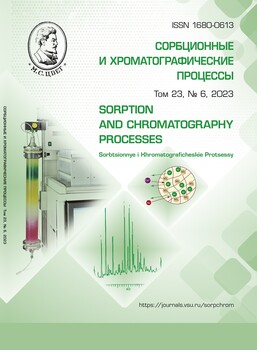Catalytic activity of modified silica gel adsorbents under conditions of methanol conversion from water-methanol waste of natural gas
Abstract
The work is devoted to the analysis of factors affecting the catalytic activity of modified silica gel adsorbents under conditions of methanol conversion to dimethyl ether. The objects of the study were the initial and modified silica gel adsorbents ASM, ASM VS, BASF KC-Trockenperlen H and BASF KC-Trockenperlen WS used in the purification of methanol from water‒methanol waste of natural gas. The purpose of this paper is to study the effect of the specific surface area, elemental and phase composition, and operating time of adsorbents on the catalytic activity of modified silica gel adsorbents under conditions of methanol conversion to dimethyl ether. The composition and structural characteristics of the samples were determined by X‒ray fluorescence, X-ray diffraction analysis and low-temperature nitrogen adsorption. Based on the results of IR‒spectrometric and thermal studies, changes in the structure of the surfaces of adsorbents during their operation by various components of organic origin were evaluated. The catalytic activity of silica gel adsorbents in methanol conversion was studied in a fixed bed reactor at atmospheric pressure in the range of 120-290°C and an optimized rate of methanol-saturated nitrogen flow of 1200 ml/min. The methanol conversion process was controlled by gas‒liquid chromatography. An increase of the catalytic activity of adsorbents in methanol conversion to dimethyl ether was found in the range of ASM VS < BASF KC-Trockenperlen WS < BASF KC-Trockenperlen H < ASM. The maximum catalytic activity at 290°C was shown by the adsorbent ASM with 4.2% aluminum oxide and an amorphous structure, which significantly reduces methanol emissions into the atmosphere. For crystalline adsorbents ASM VS with an alumina content of 13.2%, the catalytic activity was minimal. It is shown that the decrease in the catalytic activity of adsorbents in gas treatment unit during operation is associated with a decrease in the value of the specific surface area of samples with a constant content of aluminum oxide and phase state, which is associated with the possible blocking of the catalytic centers of adsorbents due to the accumulation of components of organic origin in the process of natural gas purification. The establishment of factors affecting the methanol conversion to dimethyl ether on modified silica gel adsorbents will allow managing environmental risks, as well as reducing risks to humans during transportation and disposal of water-methanol waste from natural gas purification.
Downloads
References
Kondaurov S.Y., Artemova I.I., Nikisheva M.I., Kruchinin M.M., Shajhutdinov A.Z., Zolotovskij B.P., Pilotnye ispytaniya processa adsorbcionnoj osushki i otbenzinivaniya prirodnogo gaza na rossijskih adsorbentah, Gazovaya promyshlennost', 2011; 12: 26-29.
Temerdashev Z.А., Rudenko A.V., Kolychev I.A., Kostina A.S., Effect of alumosilicate adsorbent regeneration conditions on the dehydration of methanol extracted from natural gas, Ecology and industry of Russia, 2020; 24(8): 17-21. https://doi.org/10.18412/1816-0395-2020-8-17-21
Khaleel A., Methanol dehydration to dimethyl ether over highly porous xerogel alumina catalyst: Flow rate effect, Fuel Process. Technol., 2010; 91(11): 1505-1509. https://doi.org/10.1016/j.fuproc.2010.05.028
Catizzone E., Migliori M., Aloise A., Lamberti R., Giordano G., Hierarchical low Si/Al ratio ferrierite zeolite by sequential postsynthesis treatment: catalytic assessment in dehydration reaction of methanol, J. Chem., 2019; 2019: 1-9. https://doi.org/10.1155/2019/3084356
Rashidi H., Hamoule T., Reza Khosravi Nikou M., Shariati A., DME synthesis over MSU‒S catalyst through methanol dehydration reaction, IJOGST, 2013; 2 (4): 67-73. https://doi.org/10.22050/ijogst.2013.4797
Temerdashev Z.А., Kostina A.S., Rudenko A.V., Kolychev I.A., Vasil'ev A.M., Catalytic activity of alumina–modified silica gels in methanol conversion to dimethyl ether, Russian J. оf Appl. Chem., 2021; 94(5): 576-585. https://doi.org/10.1134/S1070427221050049
Macina D., Piwowarska Z., Tarach K., Góra-Marek K., Ryczkowski J., Chmielarz L., Mesoporous silica materials modified with alumina polycations as catalysts for the synthesis of dimethyl ether from methanol, Mater. Res. Bull., 2016; 74: 425-435. https://doi.org/10.1016/j.materresbull.2015.11.018
Gao S., Xu S., Wei Y., Qiao Q., Xu Z., Wu X., Zhang M., He Y., Xu S., Liu Z., Insight into the deactivation mode of methanol‒to‒olefins conversion over SAPO-34: coke, diffusion, and acidic site accessibility, J. Catal., 2018; 367: 306-314. https://doi.org/10.1016/j.jcat.2018.09.010
Wei Y., de Jongh P.E., Bonati M.L., Law D.J., Sunley G.J., de Jong K.P., Enhanced catalytic performance of zeolite ZSM-5 for conversion of methanol to dimethyl ether by combining alkaline treatment and partial activation, Appl. Catal. A-Gen., 2015; 504: 211-219. https://doi.org/10.1016/j.apcata.2014.12.027
Groen J.C., Moulijn J.A., Pérez-Ramírez J., Desilication: on the controlled generation of mesoporosity in MFI zeolites, J. Mater. Chem., 2006; 16(22): 2121-2131. https://doi.org/ 10.1039/B517510K
Fan Y., Bao X., Lin X., Shi G., Liu H., Acidity adjustment of HZSM‒5 zeolites by dealumination and realumination with steaming and citric acid treatments, J. Phys. Chem. B., 2006; 110(31): 15411-15416. https://doi.org/10.1021/jp0607566
Raoof F., Taghizadeh M., Eliassi A., Yaripour F., Effects of temperature and feed composition on catalytic dehydration of methanol to dimethyl ether over γ-alumina, Fuel, 2008; 87(13-14): 2967-2971. https://doi.org/10.1016/j.fuel.2008.03.025
Xu M., Lunsford J.H., Goodman W.D., Bhattacharyya A., Synthesis of dimethyl ether (DME) from methanol over solid–acid catalysts, Appl. Catal. A-Gen., 1997; 149(2): 289-301. https://doi.org/10.1016/S0926-860X(96)00275-X
Temerdashev Z.А., Kostina A.S., Ryadno E.G., Vasil'ev A.M., Vasil'eva L.V., Kolychev I.A., Life cycle of silica gel adsorbents used in natural-gas purification, Protection of metals and physical chemistry of surfaces, 2022; 58(4): 696-701. https://doi.org/10.1134/S2070205122040232
Bateni H., Able C., Development of heterogeneous catalysts for dehydration of methanol to dimethyl ether: a review, Catal. Ind., 2019; 11(1): 7-33. https://doi.org/10.1134/S2070050419010045
Chukin G.D. Himiya poverhnosti i stroenie dispersnogo kremnezyoma. M., Paladin, Printa Publ., 2008, 172 p. (In Russ.)
Bellami L. Infrakrasnye spektry slozhnyh molekul. M., Izdatel'stvo inostrannoj literatury, 1963, 590 p. (In Russ.)







